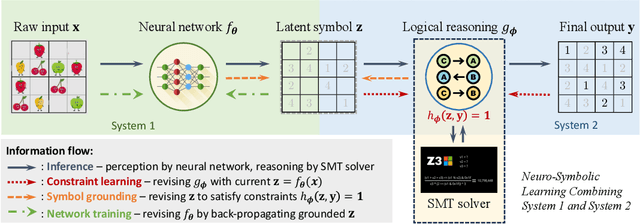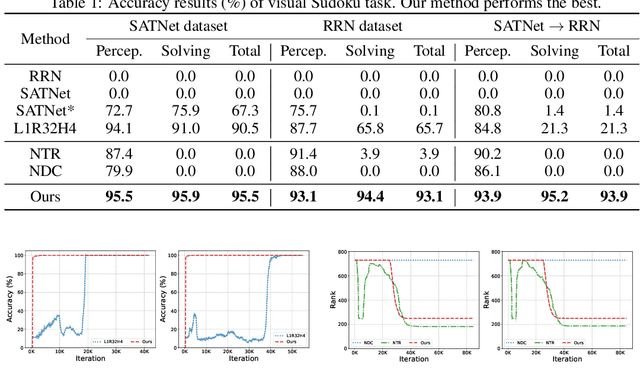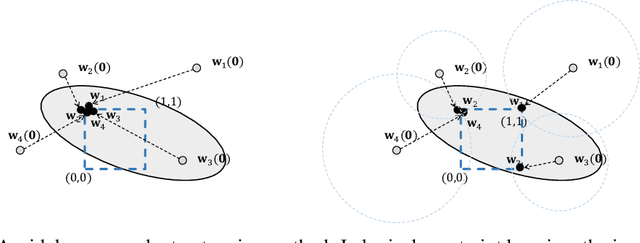Taolue Chen
CODE-DITING: A Reasoning-Based Metric for Functional Alignment in Code Evaluation
May 26, 2025Abstract:Trustworthy evaluation methods for code snippets play a crucial role in neural code generation. Traditional methods, which either rely on reference solutions or require executable test cases, have inherent limitation in flexibility and scalability. The recent LLM-as-Judge methodology offers a promising alternative by directly evaluating functional consistency between the problem description and the generated code. To systematically understand the landscape of these LLM-as-Judge methods, we conduct a comprehensive empirical study across three diverse datasets. Our investigation reveals the pros and cons of two categories of LLM-as-Judge methods: the methods based on general foundation models can achieve good performance but require complex prompts and lack explainability, while the methods based on reasoning foundation models provide better explainability with simpler prompts but demand substantial computational resources due to their large parameter sizes. To address these limitations, we propose CODE-DITING, a novel code evaluation method that balances accuracy, efficiency and explainability. We develop a data distillation framework that effectively transfers reasoning capabilities from DeepSeek-R1671B to our CODE-DITING 1.5B and 7B models, significantly enhancing evaluation explainability and reducing the computational cost. With the majority vote strategy in the inference process, CODE-DITING 1.5B outperforms all models with the same magnitude of parameters and achieves performance which would normally exhibit in a model with 5 times of parameter scale. CODE-DITING 7B surpasses GPT-4o and DeepSeek-V3 671B, even though it only uses 1% of the parameter volume of these large models. Further experiments show that CODEDITING is robust to preference leakage and can serve as a promising alternative for code evaluation.
LLM-based Automated Theorem Proving Hinges on Scalable Synthetic Data Generation
May 17, 2025Abstract:Recent advancements in large language models (LLMs) have sparked considerable interest in automated theorem proving and a prominent line of research integrates stepwise LLM-based provers into tree search. In this paper, we introduce a novel proof-state exploration approach for training data synthesis, designed to produce diverse tactics across a wide range of intermediate proof states, thereby facilitating effective one-shot fine-tuning of LLM as the policy model. We also propose an adaptive beam size strategy, which effectively takes advantage of our data synthesis method and achieves a trade-off between exploration and exploitation during tree search. Evaluations on the MiniF2F and ProofNet benchmarks demonstrate that our method outperforms strong baselines under the stringent Pass@1 metric, attaining an average pass rate of $60.74\%$ on MiniF2F and $21.18\%$ on ProofNet. These results underscore the impact of large-scale synthetic data in advancing automated theorem proving.
Less is More: Towards Green Code Large Language Models via Unified Structural Pruning
Dec 20, 2024Abstract:The extensive application of Large Language Models (LLMs) in generative coding tasks has raised concerns due to their high computational demands and energy consumption. Unlike previous structural pruning methods designed for classification models that deal with lowdimensional classification logits, generative Code LLMs produce high-dimensional token logit sequences, making traditional pruning objectives inherently limited. Moreover, existing single component pruning approaches further constrain the effectiveness when applied to generative Code LLMs. In response, we propose Flab-Pruner, an innovative unified structural pruning method that combines vocabulary, layer, and Feed-Forward Network (FFN) pruning. This approach effectively reduces model parameters while maintaining performance. Additionally, we introduce a customized code instruction data strategy for coding tasks to enhance the performance recovery efficiency of the pruned model. Through extensive evaluations on three state-of-the-art Code LLMs across multiple generative coding tasks, the results demonstrate that Flab-Pruner retains 97% of the original performance after pruning 22% of the parameters and achieves the same or even better performance after post-training. The pruned models exhibit significant improvements in storage, GPU usage, computational efficiency, and environmental impact, while maintaining well robustness. Our research provides a sustainable solution for green software engineering and promotes the efficient deployment of LLMs in real-world generative coding intelligence applications.
SimADFuzz: Simulation-Feedback Fuzz Testing for Autonomous Driving Systems
Dec 18, 2024



Abstract:Autonomous driving systems (ADS) have achieved remarkable progress in recent years. However, ensuring their safety and reliability remains a critical challenge due to the complexity and uncertainty of driving scenarios. In this paper, we focus on simulation testing for ADS, where generating diverse and effective testing scenarios is a central task. Existing fuzz testing methods face limitations, such as overlooking the temporal and spatial dynamics of scenarios and failing to leverage simulation feedback (e.g., speed, acceleration and heading) to guide scenario selection and mutation. To address these issues, we propose SimADFuzz, a novel framework designed to generate high-quality scenarios that reveal violations in ADS behavior. Specifically, SimADFuzz employs violation prediction models, which evaluate the likelihood of ADS violations, to optimize scenario selection. Moreover, SimADFuzz proposes distance-guided mutation strategies to enhance interactions among vehicles in offspring scenarios, thereby triggering more edge-case behaviors of vehicles. Comprehensive experiments demonstrate that SimADFuzz outperforms state-of-the-art fuzzers by identifying 32 more unique violations, including 4 reproducible cases of vehicle-vehicle and vehicle-pedestrian collisions. These results demonstrate SimADFuzz's effectiveness in enhancing the robustness and safety of autonomous driving systems.
Neuro-symbolic Learning Yielding Logical Constraints
Oct 28, 2024



Abstract:Neuro-symbolic systems combine the abilities of neural perception and logical reasoning. However, end-to-end learning of neuro-symbolic systems is still an unsolved challenge. This paper proposes a natural framework that fuses neural network training, symbol grounding, and logical constraint synthesis into a coherent and efficient end-to-end learning process. The capability of this framework comes from the improved interactions between the neural and the symbolic parts of the system in both the training and inference stages. Technically, to bridge the gap between the continuous neural network and the discrete logical constraint, we introduce a difference-of-convex programming technique to relax the logical constraints while maintaining their precision. We also employ cardinality constraints as the language for logical constraint learning and incorporate a trust region method to avoid the degeneracy of logical constraint in learning. Both theoretical analyses and empirical evaluations substantiate the effectiveness of the proposed framework.
LASER: Script Execution by Autonomous Agents for On-demand Traffic Simulation
Oct 21, 2024Abstract:Autonomous Driving Systems (ADS) require diverse and safety-critical traffic scenarios for effective training and testing, but the existing data generation methods struggle to provide flexibility and scalability. We propose LASER, a novel frame-work that leverage large language models (LLMs) to conduct traffic simulations based on natural language inputs. The framework operates in two stages: it first generates scripts from user-provided descriptions and then executes them using autonomous agents in real time. Validated in the CARLA simulator, LASER successfully generates complex, on-demand driving scenarios, significantly improving ADS training and testing data generation.
Softened Symbol Grounding for Neuro-symbolic Systems
Mar 01, 2024



Abstract:Neuro-symbolic learning generally consists of two separated worlds, i.e., neural network training and symbolic constraint solving, whose success hinges on symbol grounding, a fundamental problem in AI. This paper presents a novel, softened symbol grounding process, bridging the gap between the two worlds, and resulting in an effective and efficient neuro-symbolic learning framework. Technically, the framework features (1) modeling of symbol solution states as a Boltzmann distribution, which avoids expensive state searching and facilitates mutually beneficial interactions between network training and symbolic reasoning;(2) a new MCMC technique leveraging projection and SMT solvers, which efficiently samples from disconnected symbol solution spaces; (3) an annealing mechanism that can escape from %being trapped into sub-optimal symbol groundings. Experiments with three representative neuro symbolic learning tasks demonstrate that, owining to its superior symbol grounding capability, our framework successfully solves problems well beyond the frontier of the existing proposals.
Learning with Logical Constraints but without Shortcut Satisfaction
Mar 01, 2024



Abstract:Recent studies in neuro-symbolic learning have explored the integration of logical knowledge into deep learning via encoding logical constraints as an additional loss function. However, existing approaches tend to vacuously satisfy logical constraints through shortcuts, failing to fully exploit the knowledge. In this paper, we present a new framework for learning with logical constraints. Specifically, we address the shortcut satisfaction issue by introducing dual variables for logical connectives, encoding how the constraint is satisfied. We further propose a variational framework where the encoded logical constraint is expressed as a distributional loss that is compatible with the model's original training loss. The theoretical analysis shows that the proposed approach bears salient properties, and the experimental evaluations demonstrate its superior performance in both model generalizability and constraint satisfaction.
Advancing Transformer Architecture in Long-Context Large Language Models: A Comprehensive Survey
Nov 21, 2023



Abstract:With the bomb ignited by ChatGPT, Transformer-based Large Language Models (LLMs) have paved a revolutionary path toward Artificial General Intelligence (AGI) and have been applied in diverse areas as knowledge bases, human interfaces, and dynamic agents. However, a prevailing limitation exists: many current LLMs, constrained by resources, are primarily pre-trained on shorter texts, rendering them less effective for longer-context prompts, commonly encountered in real-world settings. In this paper, we present a comprehensive survey focusing on the advancement of model architecture in Transformer-based LLMs to optimize long-context capabilities across all stages from pre-training to inference. We firstly delineate and analyze the problems of handling long-context input and output with the current Transformer-based models. Then, we mainly offer a holistic taxonomy to navigate the landscape of Transformer upgrades on architecture to solve these problems. Afterward, we provide the investigation on wildly used evaluation necessities tailored for long-context LLMs, including datasets, metrics, and baseline models, as well as some amazing optimization toolkits like libraries, systems, and compilers to augment LLMs' efficiency and efficacy across different stages. Finally, we further discuss the predominant challenges and potential avenues for future research in this domain. Additionally, we have established a repository where we curate relevant literature with real-time updates at https://github.com/Strivin0311/long-llms-learning.
QVIP: An ILP-based Formal Verification Approach for Quantized Neural Networks
Dec 10, 2022Abstract:Deep learning has become a promising programming paradigm in software development, owing to its surprising performance in solving many challenging tasks. Deep neural networks (DNNs) are increasingly being deployed in practice, but are limited on resource-constrained devices owing to their demand for computational power. Quantization has emerged as a promising technique to reduce the size of DNNs with comparable accuracy as their floating-point numbered counterparts. The resulting quantized neural networks (QNNs) can be implemented energy-efficiently. Similar to their floating-point numbered counterparts, quality assurance techniques for QNNs, such as testing and formal verification, are essential but are currently less explored. In this work, we propose a novel and efficient formal verification approach for QNNs. In particular, we are the first to propose an encoding that reduces the verification problem of QNNs into the solving of integer linear constraints, which can be solved using off-the-shelf solvers. Our encoding is both sound and complete. We demonstrate the application of our approach on local robustness verification and maximum robustness radius computation. We implement our approach in a prototype tool QVIP and conduct a thorough evaluation. Experimental results on QNNs with different quantization bits confirm the effectiveness and efficiency of our approach, e.g., two orders of magnitude faster and able to solve more verification tasks in the same time limit than the state-of-the-art methods.
 Add to Chrome
Add to Chrome Add to Firefox
Add to Firefox Add to Edge
Add to Edge